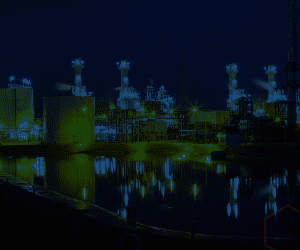Film-forming substances (FFS), intended primarily for the protection of metal surfaces, are not new. The earliest patent (known to the editors) for one such substance, octadecylamine (ODA), was issued in 1954, with first powerplant applications in the former Soviet Union and East Germany. Earlier still, FFS were used to protect shipments of military equipment during WWII.
What is more recent is focused research and trial into applications for combined-cycle plants. Hoped-for benefits include corrosion protection in heat-recovery steam generators (HRSGs), condensers, and the phase transition zone (PTZ) of steam turbines. Other benefits could be better pH control, and less chance of both single- and two-phase flow-accelerated corrosion (FAC).
But also new is an increasing risk of system and equipment damage caused by misapplication, misinformation, and failure to accurately prepare and monitor—in other words, jumping in too quickly.
Although the expected results sound great, potential damage—the industry is learning—can be great as well.
Is the use of FFS worth considering? Absolutely, especially given more cycling, low-load operation, and periods offline. Is this worth implementing, within an already complex water-chemistry program? It could be, depending on the system and equipment, and if you’re both knowledgeable and careful.
Neutralizing, filming amines. About three years ago, the CCJ-Online Team posted the following session review notes for the Combined Cycle Users Group, perhaps the only organization that covers water chemistry for the entire combined-cycle plant:
“The jury is still out on the use of amines,” but “addition of an amine with a low volatility at the pressure of concern may provide benefit: It will hang along the tube wall to protect against loss of oxygen and ammonia from that space. Absent amine, oxygen and ammonia can migrate into the bulk water, leaving the tube-wall area unprotected. Amine volatilizes later, but after protecting the tube wall.
“Bear in mind that amine blends are known to increase cation conductivity and possibly mask more corrosive anions. Their use is influenced by the severity of two-phase FAC and turbine corrosion. Monitoring of iron transport is highly recommended before introducing amine blends.”
Then CCJ ONsite published a detailed primer on this fast-approaching frontier, by EPRI’s Steve Shulder and Mike Caravaggio, entitled “Protect equipment against corrosion with neutralizing amines, filming products.” This detailed review covered the latest EPRI research into amines and filming products, monitoring of these substances in action, corrosion control in the steam-turbine PTZ, the need for new tools to quantify corrosion improvement, and a glance at ongoing research.
Since that time, the subject has been included, in some form, at all user-group meetings for combined-cycle systems and components—including turbines, HRSGs, and air-cooled condensers. Something has been happening.
A case study was noted in the inaugural (2017) HRSG Forum with Bob Anderson concluding with the importance (for all aspects of plant water chemistry) of “understanding the damage mechanisms and chemistry control options, performance monitoring, and the critical importance of acting on the measured results.” Measurement, it has been determined, is a difficult part of the overall equation.
IAPWS. The spearheading organization for both FFS research and implementation is the International Association for the Properties of Water and Steam. A key participant is Dr Barry Dooley, senior associate, Structural Integrity Associates Inc, and the executive secretary of IAPWS.
CCJ has been following Dooley (and others) on this for quite some time.
Amines, products, substances. The First International Conference on Film-Forming Amines and Products was held in Lucerne, Switzerland, in 2017. Before the second conference in 2018, organizers had issued a formal and much-needed change in nomenclature.
The term film-forming substances was introduced by IAPWS last year. Feedback from the first two conferences had indicated confusion about the various terminologies used within this relatively new field of chemistry, or what Dooley calls “a narrow topic in cycle chemistry control of powerplants.”
In response, IAPWS introduced the more general term film-forming substances. Two subsets describe these materials in terms of either being amine-based [film-forming amine (FFA) or film-forming amine product (FFAP)], or non-amine-based [film- forming products (FFP)]. FFS could now be the nomenclature for all of these substances worldwide.
FFS2019.
The Third International Conference on Film-Forming Substances, chaired by Dooley, provided a highly interactive forum for the presentation of new information and technology related to FFS, research results, case studies of powerplant and industrial applications, and open discussion among users, equipment and chemical suppliers, researchers, and industry consultants.
At the first meeting in 2017, IAPWS issued Technical Guidance Document (TGD 8-16), “Application of film-forming amines in fossil, combined cycle, and biomass power plants.” At FFS2019, there was global appreciation for and recognition of this unique document. Dooley announced that later this year, a new TGD will be issued on FFS for industrial plants, along with a White Paper on the application for nuclear plants.
It’s important to note that experience in nuclear plants, primarily for layup and storage, continues to be good with ODA the substance of choice.
Nuclear plants have been a bright spot in discussion. There generally has been low impact on the chemistry control with complete observation of hydrophobic films in the feedwater and condensate systems. However, film formation in dry-steam areas remains a question.
But experience in fossil and combined-cycle plants continues to be variable in terms of corrosion-product transport and film formation in steam circuits. Suggestions are being made, repeatedly, to improve the verification process using tube samples and corrosion-product monitoring during startups.
At FFS2019, international updates were presented on recent experiences from powerplants of all types and from industrial plants. Bulleted items below provide some specifics. Participants indicated that problems experienced at fossil and combined-cycle plants after application of FFS most often relate to increased deposition on heat-transfer surfaces which result in under-deposit corrosion
-
- Updates were provided on ongoing research activities from different international organizations dealing with decomposition of FFA, thermolysis and distribution of FFA, measuring/quantifying the concentration of FFS in the water, adsorption kinetics of film formation, and the effects of FAC.
- Many FFS mixtures contain undisclosed (proprietary) components including those commonly referred to as polycarboxylate dispersants. At high pressures these can break down and cause tube failures. Failures can also be caused by any free hydroxides that end up as sodium hydroxide during thermal breakdown. There was no understanding among participants on why a polyacrylate addition was being included in proprietary products.
- Another discussion thread was the open issues related to inspections following application of FFS to a plant, and the methods of determining hydrophobic films on surfaces, especially steam surfaces, and whether their presence can be related directly to corrosion protection.
- Little new work was presented on understanding the mechanism of the interaction of FFS with surface oxides and on how an FFS film might change the growth mechanism and morphology, and result in reduced levels of corrosion-product transfer. This relates to the interaction of the FFS film with existing oxide/deposit surfaces in condensate/feedwater and in boiler/evaporator water. Much discussion took place on the oxides which form in steam circuits, and on the chromia oxides which form in the phase transition zone of the steam turbine.
- One of the continuing conclusions from FFS2019 was the need to first optimize the current chemistry of a plant with verification, or through baseline monitoring, before application of any FFS. See “Section 8 guidance” section below.
- There were extensive discussions regarding gaps in knowledge and needs for further research work. Dooley noted that IAPWS will define, via one of the organization’s Certified Research Need documents, the work needed on the interactions occurring under all plant conditions and temperature ranges.
To sum up, there is still much to learn and a lot of fundamental work that must be done to understand the mechanisms at play with FFS—including film-formation kinetics, equilibrium and stability, film structure (for example, thickness or number of layers), how the adsorption is affected by other amines, and the correspondence to the reduction in corrosion rate through understanding of the interactions with oxides and deposits.
Cases in point. At the second annual HRSG Forum with Bob Anderson in 2018, EPRI’s Shulder concentrated on FFS application for both corrosion resistance and layup protection. He stated that amine/filming technology is increasingly considered for the following base benefits:
-
- Non-optimized corrosion product transport with recommended feedwater treatment program.
-
- Cyclical operation with a number of startups.
- Excessive ammonia may result in vapors within plant and short polisher runs.
-
- Two-phase FAC damage.
-
- Neutralizing amines may provide better dissociation and distribution than ammonia.
- Higher localized at-temperature pH.
-
- Better layup protection during outages of variable duration.
-
- Film-forming products place a hydrophobic barrier between metal surface and liquid.
- Limit on capital expenditures or labor (dehumidified air).
-
- Non-optimized corrosion product transport with recommended feedwater treatment program.
One highlight of FFS2019 was a presentation entitled “Cycle chemistry issues due to the incorrect application of a film-forming substance,” by David Addison, principal, Thermal Chemistry Ltd, Hamilton, New Zealand.
The case presented was a 600-MW (4 × 150 MW) coal-fired station in Australasia, commissioned in 2010. The plant features a reverse-osmosis/mixed-bed demineralizing plant and is seawater-cooled (no condensate polisher, copper condenser). The feedwater system is all-ferrous.
Although a coal-fired facility, the FFS issues presented are common considerations in both conventional and combined-cycle plants.
The site was commissioned on AVT(R) with phosphate treatment in the boilers, but converted to a film-forming product in 2011. Chemistry guidelines at the plant were described as “limited.”
FFS details (contents) were listed as follows:
-
- Oleyl propylenediamine (OLDA).
- Cyclohexylamine.
- 2-aminoethanol.
- Polycarboxylate dispersants (details not known).
Treatment, co-dosed with ammonia, was manually applied and tested with a target concentration (as product) of 12 ppm.
A local agent supplied the product and used “consumption of product” as the basis for testing. Publicly available information from the vendor states the product was formulated “for steam and water systems with softened feedwater” (obviously not the case for this plant), and for plants without a steam turbine, also clearly not the case for this coal-fired facility.
Site steam/water analysis. At the time of the plant review by Addison, no online analyzers were functional and the majority of the sample points themselves were not functional. The entire analysis system had been out of service for eight years, and very little manual sampling and testing was being performed. According to the owner/operator, the site had been told by the FFS vendor that, thanks to the FFS program, there was little need for any online sampling and analysis.
Condenser tube leaks were occurring, undetected.
Major plant issues. Significant boiler waterwall and superheater tube failures were happening causing unplanned forced outage. FAC was causing failures in the feedwater system (with high iron levels). The following observations were made:
-
- There were multiple feedwater pipework/heater failures consistent with FAC attack.
- Multiple HP heaters had been removed from service because of excessive and repeated leaking.
- Significant amounts of iron oxides were observable in functioning manual sample points (economizer inlet and boiler).
Overdosing of the FFS (above 130 ppm) was at times causing blockages and so-called gunk balls.
No condition-assessment tube samples were taken at the plant during the time under review, and there was no tube failure reduction program in place. Tube analysis by the FFS product vendor was characterized only as “rudimentary.”
The steam turbine was experiencing deposits, pitting, and cracking. Deposits were present on all blades (HP/IP/LP) and no carryover testing was being performed. The first and only turbine-deposit analysis was undertaken by Addison in 2019 during an overhaul and repair outage.
Deposits were consistent with continuous carryover and spray-water contamination while operating with condenser tube leaks:
-
- Silica, sodium, and chloride dominated deposits with high sodium and chloride amounts relative to the IP.
- Silica, sodium, and chloride dominated deposits.
- Silica dominated deposits.
None of the saturated- or superheated-steam sample points were functional.
Section 8 guidance. A key point made by Dooley at the Air-Cooled Condenser Users Group annual meeting in 2018 was the importance of correct application of IAPWS TGD 8-16, specifically Section 8. It provides clear guidance for applying film-forming substances to generating plants as a supplement to, or as a replacement for, the current chemistry regime—clearly something not apparent to the owner/operator of the plant discussed above.
Addison said that the following key activities had not taken place before conversion from AVT(R)/phosphate treatment to a film-forming product:
1. Tube samples had not been taken and analyzed to understand the oxide condition of the unit. Chemical cleaning might have been needed.
2. A detailed internal inspection of the plant had not been undertaken.
3. A full baseline set of functioning chemical analyzers did not exist.
4. There was no full baseline set of data for corrosion-product transport.
5. There should have been a full composition breakdown of the FFS product so thermal degradation products could be assessed.
TGD non-compliance. Addison’s presentation at FFS2019 pointed out that FFS products, “if applied correctly and in the right circumstances, can actually work really well for offline protection.” He continued, “Baseload is often a challenge to justify the cost versus the potential benefits, but if a combined cycle is off and on then it should at least be carefully considered to determine if a technical and economic use case is present.”
Addison also is involved in development of international cycle-chemistry guidelines for industry, both IAPWS and EPRI. He is the vice chair of the IAPWS Power Cycle Chemistry Group and chairs the New Zealand Association for the Properties of Water and Steam.
The Australasian plant experience above was a classic example of failure to follow IAPWS TGDs for an FFS program or any other aspect of cycle chemistry, and of being entirely reliant on substandard technical advice from a chemical vendor.
The current FFS program at the plant in Australasia has been stopped, pending resolution of other issues. Boiler-tube-failure and turbine-deposit analyses are now underway to determine the precise root causes. A complete steam/water sampling system upgrade has begun, key elements of a boiler-tube failure reduction program are in place, and both cycle chemistry and IAPWS TGD familiarization training have been implemented.
Ongoing discussions. Other related presentations at FFS2019 included long-term preservation (two years) of a coal-fired plant in Germany (good hydrophobicity and no corrosion), and successful use of FFS as a corrosion inhibitor at a combined-cycle power station in the UK.
Also noted was a major challenge with layup and storage of combined cycles, namely the impact on air-cooled condensers. The topics of FFS and cycle chemistry are included in meetings of the Air-Cooled Condenser Users Group.
FFS2020 remains in the planning stages for early next year, with a probable location in France. Details will be announced in CCJ and on the IAPWS website.
The topic also will be included in the upcoming HRSG Forum with Bob Anderson, July 22-24, at the Hilton Orlando.
Film-forming applications for selected component and surface protection are an ongoing target of active research and trial. Experiences, both good and bad, are finally getting the attention they deserve. Most deserving is the clear message to apply due diligence and tread carefully!
Learn from the experts on powerplant chemistry
David Addison, principal, Thermal Chemistry Ltd, a frequent contributor to CCJ on cycle chemistry, called to recommend attendance at the 2019 PowerPlant Chemistry Forum, Sept 26-27, in Washington DC. Addison, who works globally out of his New Zealand office, chairs his country’s committee to the International Association for the Properties of Water and Steam, which develops cycle-chemistry guidelines for industry. He also serves as the vice chair for the IAPWS Power Cycle Chemistry Group.
The fall meeting, which will focus on the latest developments in cycle chemistry of interest to asset and plant managers, operations personnel, plant engineers and chemists, services providers, and others, addresses the needs of combined-cycle, conventional fossil, and nuclear plants.
Preliminary agenda topics include the following:
-
- Cycling operation and its chemistry challenges.
- Startup and layup strategies for chemistry control.
- Chemical control and monitoring.
- Sampling systems and instrumentation.
- Lifecycle chemistry optimization and management.
The steering committee is organizing a program that consists of both invited and contributed technical papers and provides adequate discussion time. Committee members, in addition to Addison, are:
-
- Chair Michael Rziha, PPChem AG (Switzerland).
- Steve Shulder, EPRI.
- Doug Hubbard, AEP.
- Chad McKnight, Southern Company.
- Erin Westberg, FPL/NextEra.
- Mike Rupinen, LG&E and KU.
- Randy Turner, Swan Analytical USA.
Follow program developments on the PowerPlant Chemistry website.









